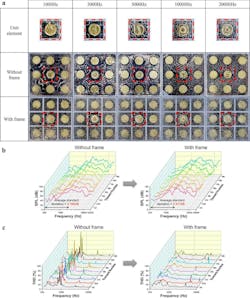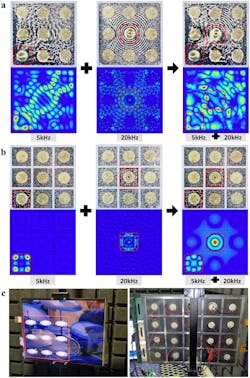Two for One: OLED Screen Also Supports Pixel-Based Sound
What you’ll learn:
- Why audio-emitting OLED displays have been a design challenge.
- How a team at South Korea’s POSTECH developed what they maintain is the world’s first pixel-based, local sound OLED, where each pixel emits distinct sound.
- How the display integrates ultra-thin piezo exciters while achieving nearly crosstalk-free multichannel audio performance.
Most current displays still require external soundbars or multichannel speakers, which add bulk and create design challenges—especially in compact environments like vehicle interiors, where integrating multiple speakers is difficult.
To address this, researchers have focused on integrating advanced sound capabilities directly into OLED panels, known for their slim, flexible form factors. While companies have explored attaching exciters to the back of TVs or bending OLEDs around speakers, these methods still rely on bulky hardware and face challenges in accurate sound localization.
The core issue is that traditional exciters are relatively large and heavy, making it difficult to deploy multiple units without interference or compromising the OLED’s thin design. In addition, sound crosstalk between multiple speakers leads to a lack of precise control over localized audio.
A team at Pohang University of Science and Technology (POSTECH)/South Korea has overcome these challenges by embedding ultra-thin piezoelectric exciters within the OLED display frame. These piezo exciters, arranged similarly to pixels, convert electrical signals into sound vibrations without occupying external space. Also noteworthy is that they’re fully compatible with the thin form factor of OLED panels (Fig. 1).
As a result, each pixel can act as an independent sound source, enabling pixel-based local sound technology. The researchers also developed a method to eliminate sound crosstalk, ensuring that multiple sounds from different regions of the display don’t interfere with each other—something previously unattainable in multichannel setups.
Vibration Localization Approach
Issues such as sound crosstalk between exciters and non-uniform frequency responses often compromise audio quality. To address these problems, the researchers explored frame-based, sound-vibration isolation strategies to localize surface vibrations and reduce interference across multiple exciters.
>>Check out this TechXchange for similar articles and videos
Unlike conventional efforts that focused on high sound pressure level (SPL) and low total harmonic distortion (THD), their research wasn’t aimed at improving absolute speaker performance. Rather, it focused on vibration localization and frequency-response consistency through structural modifications.
They introduced vibration-isolating frames made from materials stiffer than the diaphragm, such as the display panel, to separate the regions between exciters. This design confined vibrations to the targeted area of each exciter, effectively preventing interference (Fig. 2).
The panel speaker was constructed by attaching commercially available lead-zirconate-titanate (PZT) elements to the diaphragm. Each PZT element consists of a three-layer structure: a bottom electrode, a PZT material, and a top electrode. Frames were added to this speaker structure, with one model supporting only the outer edges and another featuring frames that isolate each exciter's region to localize vibrations of sound. Their experimental design standardized in a 3×3 array configuration.
The wave generated by a signal applied to a single exciter propagates across the diaphragm, resulting in surface vibrations. While these vibrations typically spread across the diaphragm, the frame design confines each exciter's vibrations to its designated area, reducing interference and distortion.
Test Results on Frequency Response Uniformity and THD
They combined experimental measurements and finite-element-method (FEM) simulations, and found that increasing frame height and width, along with using materials with different acoustic impedance for the diaphragm, significantly improved frequency response uniformity and reduced THD. These enhancements simplify speaker response compensation, ensuring reliable, high-quality sound output.
Using Chladni patterns, they verified crosstalk-free vibrations on the diaphragm surface, confirming the frames’ effectiveness in isolating exciters. Without frames, the diaphragm shows variable frequency responses based on exciter location. With frames, each exciter operates within its own defined section, achieving localized vibration and consistent frequency response. This frequency response uniformity simplifies compensation processes, reducing the need for complex DSP, crossover, and filtering adjustments.
[Chladni patterns are named for Ernst Chladni, a late 18th/early 19th-century physicist who specialized in acoustics and did much of the pioneering work on which we still rely. These eponymous patterns are formed on a flat surface when it vibrates at specific frequencies.
Until recently, the patterns were visualized by sprinkling sand or other fine material on the surface of interest, which then moves away from the antinodes (points of maximum vibration) and accumulates at the nodes (points of minimal vibration). Now, of course, it’s usually done with computer-based modeling, but the name is still used for the visual representation—and real sand is still used in many cases.]
They modeled and built units with a wide range of frame widths and heights to determine the effect of dimensions as well as the impact on acoustic impedance between element sections. One of their many examples is shown in Figure 3.
Conclusion
The frames effectively confined surface vibrations to designated areas, preventing propagation to adjacent regions and enhancing frequency response uniformity, which reduced standard deviation and simplified the response compensation process. Furthermore, increasing the frame height and width improved frequency response uniformity and reduced THD across a broader frequency range, resulting in clearer and more accurate sound reproduction.
Frames with a large acoustic impedance contrast to the diaphragm material demonstrated superior performance in vibration confinement and overall speaker performance.
Finally, they built a realistic 13-in. OLED display with integrated localized sound, and long-term reliability tests confirmed that the fabricated speakers maintained stable performance, showing consistent and predictable SPL variations with changes in input voltage and distance.
These findings highlight the potential of frame-based designs to substantially improve sound quality and durability in piezoelectric panel speakers and automotive applications. They note that this frame-based vibration localization mitigates crosstalk issues by confining vibrations within specific regions, ensuring precise sound localization. This method is particularly suited for dashboard-integrated OLED speakers and multi-zone in-car sound systems, where spatially optimized audio is essential.
The work is described in detail in their paper “Localized Sound-Integrated Display Speaker Using Crosstalk-Free Piezoelectric Vibration Array” published in Advanced Science. The paper incudes discussion of the concept, theoretical analysis, modeling, fabrication of units, experimental setup, test results, and much more.
>>Check out this TechXchange for similar articles and videos
About the Author

Bill Schweber
Contributing Editor
Bill Schweber is an electronics engineer who has written three textbooks on electronic communications systems, as well as hundreds of technical articles, opinion columns, and product features. In past roles, he worked as a technical website manager for multiple topic-specific sites for EE Times, as well as both the Executive Editor and Analog Editor at EDN.
At Analog Devices Inc., Bill was in marketing communications (public relations). As a result, he has been on both sides of the technical PR function, presenting company products, stories, and messages to the media and also as the recipient of these.
Prior to the MarCom role at Analog, Bill was associate editor of their respected technical journal and worked in their product marketing and applications engineering groups. Before those roles, he was at Instron Corp., doing hands-on analog- and power-circuit design and systems integration for materials-testing machine controls.
Bill has an MSEE (Univ. of Mass) and BSEE (Columbia Univ.), is a Registered Professional Engineer, and holds an Advanced Class amateur radio license. He has also planned, written, and presented online courses on a variety of engineering topics, including MOSFET basics, ADC selection, and driving LEDs.




